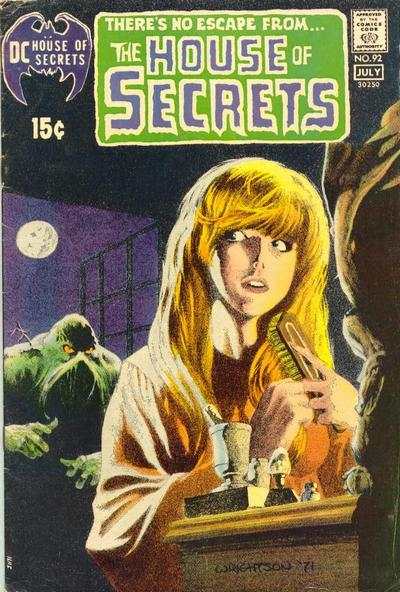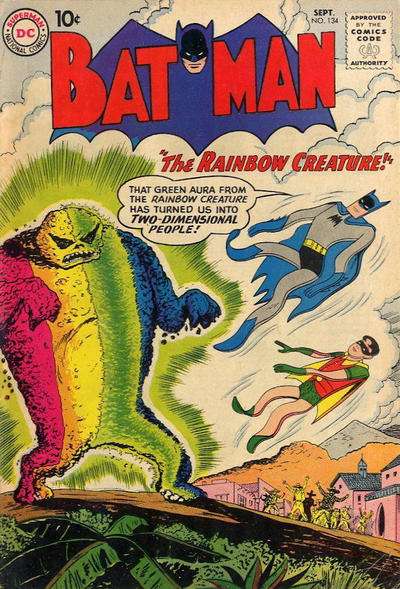Fiction House is an
American publisher of
pulp magazines and
comic books that existed from 1927 to the 1950s. The later-day owner's comics division was best known for its
pinup-style
good girl art, as epitomized by the company's most popular character,
Sheena, Queen of the Jungle.
Fiction House was co-founded in 1927 by J.W. Glenister and John B.
"Jack" Kelly, whose editorial offices were located at 366 Fifth Avenue,
New York City. It began as a pulp-magazine publisher of primarily aviation, Western,
Adventure and Detective stories, and sports pulps. "Action Stories" was
the publisher's first imprint. The front covers of Fiction House
magazines featured the original firm's distinctive bulls-eye as its
trademark and logo. (citations: Comic Books - Pulp Magazines Project,
www.pulpmags.org/contexts_pages/comics/comics.html)
History
Titles from other well-known pulp magazine publishers of the 1930s
and 1940s include Battle Stories, Complete Love Magazine, Startling
Comics, Thrilling Comics, War Comics, and Western Love Trails.
Publishers include Hillman Periodicals, Ace Magazines, Standard,
Fawcett, and Dell. However -- Nearly half of the titles featured were published by Fiction House alone,
including Air Stories, Wings, Action Stories. (citation: pulpmags.org;
The Pulp Magazines Project, an archive of all-fiction pulpwood magazines
from 1896-1946; The Digital Comic Museum.)
Detective Book Magazine Vol. 5, #10 (Winter 1948)
Fiction House's "Air Stories" Considered "The First Air Story
Magazine" According to Alexandra Blair (University of Mississippi)
writing for The Pulp Magazines Project: "In May 1927 Charles Lindbergh
made his world-famous solo flight across the Atlantic, catapulting
himself (and The Spirit of St. Louis) into the history books and America
into an "air-minded" frenzy. The "golden era" of aviation fiction had
begun. In the next five years, 148 aviation series and dozens of
aviation pulps like Air Trails, Air Adventures, Dare-Devil Aces, Flying
Aces, Sky Trails, and Wings would come into print.
"Amid stiff
competition, Fiction House's Air Stories, edited by Jack B. Kelly
(1927-1932) and Malcolm Reiss (1937-1939), held a unique bragging right;
its first issue appeared in August 1927, making it "The First Air Story
Magazine!" as prominently advertised on many of the magazine's
covers. Air Stories not only could claim status as a "first," but also
often featured some of the most popular talent in the aviation genre.
The artwork of Rudolph Belarski, Frank Tinsley, and Frederick Blakeslee,
the top three air-war illustrators of the day, regularly graced Air
Stories's covers, and its pages were filled with stories by the likes of
Thomson Burtis, author of the Rex Lee series, and George Bruce, whose
popularity led to three aviation pulps being named after him. (citation:
Pulp Magazines Organization, The Pulp Magazines Project).
The publishing firm's Editor, John B. "Jack" Kelly—the driving force
behind the founding of Fiction House—died unexpectedly in 1932 at the
age of 43. Soon after, J.W. Glenister sold the firm and retired to
California. (citation: The Kelly Family Archives.)
"By the 1930s, Fiction House had expended into detective mysteries.
[1] Publisher Thurman T. Scott, whose Fiction House group included the
pulp-magazine imprints
Glen-Kel and
Real Adventures Publishing Co.,
[citation needed] expanded into
comic books in the late 1930s when that emerging medium began to seem a viable adjunct to the fading pulps. Receptive to a sales call by
Eisner & Iger,
one of the prominent "packagers" of that time who produced complete
comic books on demand for publishers looking to enter the field, Scott
released
Jumbo Comics #1 (Sept. 1938).
[2]===
Jumbo and Jack Kirby=== Fiction House star
Sheena, Queen of the Jungle appeared in that initial issue.
Will Eisner and
S.M. "Jerry" Iger had created the leggy, leopard-wearing jungle goddess for the
British magazine
Wags,
[3] under the joint pseudonym "W. Morgan Thomas".
[4]
Fiction House's other features in that initial foray included the period adventure "Hawks of the Seas" (continuing a story from
Quality Comics'
Feature Funnies
#12, after Eisner-Iger and Quality had had a falling out), and several
now-obscure strips ("Peter Pupp"; "ZX-5 Spies in Action"; "Spencer
Steel"; "Inspector Dayton").
[5] These include three by future industry legend
Jack Kirby, representing his first comic-book work following his debut in
Wild Boy Magazine:
[6] the
science fiction feature
The Diary of Dr. Hayward (under the pseudonym "Curt Davis"), the modern-West crimefighter strip
Wilton of the West (as "Fred Sande"), and Part One of the
swashbuckling serialization of
Alexandre Dumas, père's
The Count of Monte Cristo (as "Jack Curtiss"), each four pages long.
"The big 6 of the comics"
Jumbo proved a hit, and Fiction House would go on to publish
Jungle Comics; the
aviation-themed
Wings Comics; the
science fiction title
Planet Comics;
Rangers Comics; and
Fight Comics
during the early 1940s — most of these series taking their titles and
themes from the Fiction House pulps. Fiction House referred to these
titles in its regular house ads as "The Big Six," but the company also
published several other titles, among them the
Western-themed
Indians and
Firehair, jungle titles
Sheena, Queen of the Jungle and
Wambi, and five issues of Eisner's
The Spirit.
[7]
Quickly developing its own staff under editor Joe Cunningham followed by Jack Burden,
[8] Fiction House employed either in-house or on a freelance basis such artists as Meskin,
Matt Baker (the first prominent
African-American artist in comics),
Nick Cardy,
George Evans,
Bob Powell, and the British
Lee Elias, as well as such rare female comics artists as
Ruth Atkinson,
Fran Hopper,
Lily Renée, and
Marcia Snyder.
Feminist comics historian
Trina Robbins, wrote that
 ...most of [Fiction House's] pulp-style action stories either starred
or featured strong, beautiful, competent heroines. They were war
nurses, aviatrixes, girl detectives, counterspies, and animal skin-clad
jungle queens, and they were in command. Guns blazing, daggers
unsheathed, sword in hand, they leaped across the pages, ready to take
on any villain. And they did not need rescuing.[9]
...most of [Fiction House's] pulp-style action stories either starred
or featured strong, beautiful, competent heroines. They were war
nurses, aviatrixes, girl detectives, counterspies, and animal skin-clad
jungle queens, and they were in command. Guns blazing, daggers
unsheathed, sword in hand, they leaped across the pages, ready to take
on any villain. And they did not need rescuing.[9]
Despite such pre-feminist pedigree, (by the 1940-50s) Fiction House found itself targeted in
psychiatrist Dr.
Fredric Wertham's book
Seduction of the Innocent (1954), which in part blamed comic books for an increase in
juvenile delinquency. Aside from the ostensible effects of gory
horror in comic books, Wertham cast blame on the sexy, pneumatic heroines of Fiction House,
Fox Comics and other companies. A subsequent, wide-ranging investigation by the
Senate Subcommittee on Juvenile Delinquency, coupled with outcry by parents, a downturn in comics sales, the demise of the pulps, and the rise of television and
paperback novels
competing for readers and leisure time, Fiction House faced an
increasingly difficult business environment, and soon closed shop.













